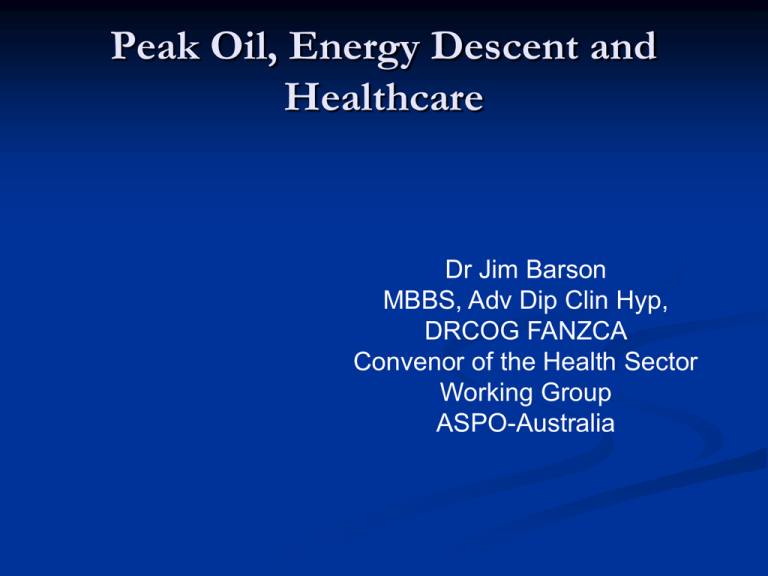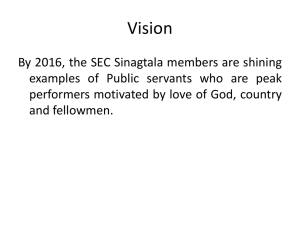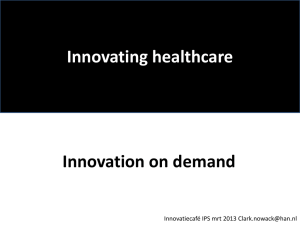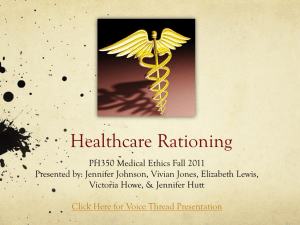Oil Vulnerability of WA`s Health System
advertisement

Peak Oil, Energy Descent and Healthcare Dr Jim Barson MBBS, Adv Dip Clin Hyp, DRCOG FANZCA Convenor of the Health Sector Working Group ASPO-Australia Will Global Oil Shortages Occur in the Short-Medium Term? Bruce Robinson, Convenor 16th May 2012 Key takeaways: 40 1. Serious global oil shortages are quite likely in the near term. The evidence is mounting. 30 Peak Oil but when? 20 2. Forward planning should include serious consideration of "Peak Oil" scenarios 10 3. Oil vulnerability assessment could be a valuable precaution 0 1930 1 21 1970 41 61 2010 81 101 2050 121 ● What is Peak Oil ? It is the time when global oil production stops rising and starts its final decline ● When is the most probable forecast date ? 2014 +/- 5 years Why is the risk being largely ignored? ● “Peak Exports” will arrive sooner, as exporting countries use more of their own oil internally, leaving less for export www.ASPO-Australia.org.au An Australia-wide network of professionals working to reduce oil vulnerability Working groups Oil & Gas industry Urban and transport planning Finance Sector Health Sector Social Services Sector Regional and city Defence and Security Conservation and Environment Remote & indigenous communities Active transport (bicycle & walking) Agriculture, Fisheries and Food Biofuels Construction Industry Public transport sector Economics Tourism Children and Peak Oil Young Professionals working group Revised edition, 2008 Why do leaders consistently ignore looming signs of crises even when they know the consequences could be devastating? Most events that catch us by surprise are both predictable and preventable, but we consistently miss (or ignore) the warning signs Is Peak Oil a "Predictable Surprise" which is being ignored?? Sydney Morning Herald, 10th July 2008 Oil prices to double by 2022, IMF paper warns with sweeping implications for the global economy, according to a report commissioned by the International Monetary Fund. (West Australian 15th May 2012) Global oil production limits are in sight. Macquarie report, 2009 Peak Oil, Energy Descent and Healthcare The anaesthetist, by training and disposition, is a vigilant pessimist. Introduction The Impact on Healthcare Delivery of Peak Oil & Energy Descent Global National Regional Local Professional Barriers to progress and possible strategies Global The medical industrial complex is global Globalisation has been based on Low costs Wages Materials Energy Transport It has resulted in Extreme centralisation For example most of the world’s disposable syringes are made in just a few factories in Asia Very long and vulnerable just-in-time supply chains Global Our healthcare system is part of a global system that is optimised for efficiency at the expense of resilience Container ships have halved their speed to save fuel Efficiency vs. Resilience trade-off is unwinding. Just-in-time delivery becoming unreliable Warehousing and redundancies necessary New model should be ‘Just-in-case’ Systemic Risk Economic Global Oil is Growth Systemic Risk The global → financial crisis Not enough capital for alternative energy projects ← Peak oil & energy descent Not enough oil to grow out of unsustainable debt Systemic Risk Structural The Diminishing Return on Increasing Complexity Highly complex and interconnected systems are inherently unstable and prone to collapse (1) Energy and Complexity High energy inputs are required to sustain complex systems. Energy and Complexity High energy systems allow niche specialisation Energy and Complexity Low energy inputs result in low complexity systems Energy and Complexity Low energy input favours flexibility Less energy = Less complexity Our future will not be a linear extrapolation from the past through the present and beyond because we are approaching a period of unprecedented change. What to do with our diminished capacity? Stem cell therapy? The pursuit of esoteric individual therapy Vaccine production? The pursuit of public health Systemic Risk Modern healthcare is an open, high energy, extremely complex system of material and human inputs and outputs. Each material input to the system eg. pharmaceuticals, is in turn a network (often global) of subsystems. Each material output eg. contaminated waste, is likewise a network of subsystems. Staff and patients require some mix of transport systems to provide around the clock mobility. Each system and subsystem consists of a chain of steps, each of which is in some way dependant on the ready availability of low cost, high energy petroleum. Systemic Risk Peak oil is a ‘Preconditional Crisis for Healthcare’ (2) Healthcare delivery is a highly complex system that requires huge inputs. Energy per se Petroleum derived products It’s not just energy Anaesthetics, antibiotics, anti-histamines, antiseptics, artificial limbs, aspirin, balloon pumps, bandages, bottles, blankets, bypass pumps, cameras, cannulae, carpet, catheters, CDs, computers, condoms, contacts, cortisone, creams, CT scanners, dental equipment, deodorisers, detergents, dressings, dryers, ducting, DVDs, endotracheal tubes, glues, gowns, fibre-optic equipment, hearing aids, heart valves, heating equipment, ink, insulation, IV fluid bags and tubing, laryngeal masks, lubricating gel, masks, mops, mortuary supplies, MRIs, needles, offices supplies and equipment, ointments, oxygenators, paraffin, pathology equipment, pens, petroleum jelly, plastic chairs, plastic cups, plastics bags, plastic wrap, packaging, pharmaceuticals, refrigerators, rubber bands, rubber boots, rubber gloves, rubbish bags, scrub brushes, solvents, speculums, sterilisers, sterile packaging, stethoscopes, stomal therapy supplies, suppositories, syringes, surgical drapes, surgical stockings, sutures, tape, trays, trolleys, tyres, ultrasound equipment, vaporisers, video equipment, water pipes, water filters, wheels, X-ray films. And all the trucks, fuel and logistical support to move this stuff and all the masses of food, linen and non petroleum supplies into and out of every healthcare facility everyday without any delay. Systemic Risk Cascading system failure is a real risk Failures in manufacturing, transport or delivery of critical components could bring widespread chaos Standardisation and stockpiling Risk Management Exposure Transport fuel Medical plastics Pharmaceuticals Equipment and spare parts Susceptibility Resilience Adaptive management Adaptive Management Developed to cope with non-linear variables in the resource industries Applicable to public health and peak oil Adaptive Management Elements 1. 2. 3. 4. 5. 6. Management objectives regularly revisited and accordingly revised Model the system Monitor and evaluate outcomes Range of management options Mechanisms to incorporate learning into decisions Collaborative structure for stakeholder participation and learning Adaptive Management Steps 1. 2. 3. 4. 5. 6. Assessment Planning Implementation Monitoring Evaluation Adjustment Transport Healthcare accounts for 11% of the workforce Public transport Not suitable for the sick Not available at night Active transport Limited radius Good for staff, if supported Will result in decreases in: Obesity Diabetes Heart disease Road trauma Air pollution Impact on climate Regions, hospitals and clinics may need to provide Targeted medical public transport SmartCard fuel allocation Plastics Plastics manufacture accounts for 4% of petroleum usage (mostly NG) Medical usage accounts for about 4% plastic consumption Logistic and economic factors more important than feedstock Disposable vs reusable (silicone) Infection control dogma Pharmaceuticals Pharmaceuticals Pharmaceutical manufacturing accounts for about 4% of petroleum usage Extreme case of value adding Logistics and distribution What do we really need? WHO list of essential medicines Plant based medicines Traditional therapies Equipment and Spare Parts What do we really need? General practice Anaesthesia Intensive What will happen to global supply chain Just-in-Case rather than Just-in-Time Warehousing What can make in Australia Generic/Modular Global Refugees from famine and climate change could arrive in large numbers The post peak oil carrying capacity of Australia is unknown but likely to be lower Famine promotes infectious disease MDRTB Malaria HIV Avian influenza The ethical dilemma of the life boat may arise National The national economy will contract Demands on the public purse will increase Tax revenues will decrease Private health insurance will decrease Private hospitals will treat more public patients Fee for service private practice will decrease Local manufacture of generic equipment, drugs and supplies What do we really need? The WHO formulary and catalogue (6) National Health system is already severely stressed Peak Demand & Peak Oil will overlap All costs are Energy Costs Rationing Fuel drought Rationing Healthcare Level Five Water Restrictions Need for novel Solutions National Rationing Already happening by stealth Public: Waiting lists Private: Cost In the near future capacity constraints will become obvious, unavoidable and unfudgable The discussion must be open and honest Rationing is sharing National - Rationing The Big Questions best handled at a national level Who? Gets what treatment? Where? When? How? From whom? At whose expense? National - Rationing Guidelines for entry into northern regions end stage renal failure program. Auckland: Northern Regional Health Authority (3) Treatment would be of little physical and physiological potential benefit to the patient End stage disease in any other system which will not be improved by treatment Disease processes from which the patient will die within two years The compliance potential is not positive in that the patient is not able to cooperate with an active therapy Treatment is not in the best interests of the person as perceived by the assessing team, or is considered futile. (Examples would include those patients suffering from a severe dementia who are unable to feed, dress or toilet independently.)" National - Rationing The Oregon Experiment (4) needs to be reassessed A community consultation process that generated a list of treatment priorities Developed a 16 box matrix Life cycle stages: Infancy, childhood, adult, elderly Level of care: Critical, short term, long term, preventative Priority: High, medium, low Ranked list of conditions with a cut off line for public funding State Redefining boundaries Geographic mobility Procedural complexity Urban Urban fringe Regional Rural Remote Access to all resources Access to most resources Access to most resources Access to some resources Access to few resources ARIA Highly Accessible (ARIA score 0 - 1.84) Accessible (ARIA score >1.84 - 3.51) Moderately Accessible (ARIA score >3.51 5.80) Remote (ARIA score >5.80 - 9.08) Very Remote (ARIA score >9.08 - 12) Specifically excludes ‘Transport Disadvantage’ from assesssment Regional Relocalise Integrate GPs into pre and post hospital care ↑ Level of primary care with support and resources Triage (+/- treatment) before travel Redistribute Develop local facilities Consulting Day surgery Allied health Regional High speed broadband ‘Stranded’ Patient ↔ Consultant ‘Stranded’ GP ↔ Consultant Live in facilities for staff Smart card fuel rationing Community discussion and comment Rationing is sharing Professional All doctors try to ‘work the system’ to advantage each individual patient (and themselves) What is best for the sum of all individuals is not necessarily what is best for the community as a whole Rationing of service provision is inevitable We will need to be frugal, inventive, innovative, conservative and courageous as we power down General Practice Increased demand especially on outer suburban and country doctors Historical comparison Training and support What can be done? Where can it be done? Increased role for small hospitals Alternative Therapies Claims of efficacy without scientific trials are unjustified ‘The therapeutic trance” Some are potentially harmful Those that actually can be proven to work will have a valuable role to play 10% 30% 30% 30% rule of general practice as applied to ‘successful’ ineffective therapies. Pursuit of alternative therapy can delay definitive treatment In a time of diminished funding only proven treatments should be funded from the public purse Medical Indemnity and Risk We can’t eliminate all risk now and will be even less able to with decentralised care Care will have to be the best that can provided with the manpower and resources available Medico-legal decision making is not be sustainable, defensive medicine is very resource intensive No fault compensation would be will be essential for rural GPs servicing stranded populations Governmental Responses Urgent Oil Vulnerability Analysis In the mean time develop ‘No Regrets’ strategies Active Transport Public transport Enhance community centred health services Broaden and deepen general practice training Professional Responses Discuss peak oil and energy descent Oil vulnerability analysis Plan for the decentralisation of service delivery Develop, enhance and support GP training FARGP ACRRM Specialist GPs: O&G, Surgery, Anaesthetics, Psychiatry etc Expanded to non-rural practitioners Reduce waste and plan return to reusable equipment where possible Trailing edge vs leading edge technology (7) Discuss the Cuban model of healthcare Barriers to Progress -1 Bureaucratic Paralysis It is easier to rely on ‘Plausible Deniability’ than stick your neck out Errors of commission are seen to be worse than errors of omission It’s good to be correct, but if you have to be wrong it is best to be wrong at the same time as everyone else Barriers to Progress -2 Human nature Our personal and social resources are seriously depleted Our brains run on ‘The Get More Energy Operating System’ The maturity of the individual. The general mindset of the society as a whole and the local community (peer pressure). The mental and physical skill set that each person possesses and the skill sets that exist as a whole. (5) The mainstream media are actively antagonistic Sell advertising not news ‘The Iron Triangle’ Real estate Finance Car industry Education Campaign Promote open discussion about peak oil Accept limits to growth and progress Steady state economic theory Develop and promote new models of individual and social success CARPE DIEM A Predicament A situation that can not be changed and must be accepted A Problem A situation that might have a set of a solutions Personal Reponses Responsibility For health and wellbeing Prevention is essential when cure is not possible For food security For family members For neighbours Personal To maintain physical and mental health we should learn: How to get around without a car, teach kids as well Frugality, patience and self restraint Useful skills: gardening, knitting, use of tools Tolerance, how to get along with boring, annoying and difficult people To lose any delusions of autonomy and learn how to cooperate and defend the commons To produce, preserve and cook food To reduce, reuse, repair and recycle To make ones own fun Personal To maintain financial health one should endeavour to: Get out of debt, economise, think of how you might live on half your income Move to the non-discretionary side of the economy, aim to satisfy needs not wants Reduce, reuse, repair, recycle Produce as much as you can of what you need and something of value to others Get to know the neighbours, share skills and resources, nobody can do everything but everyone can do something. Community Reponses Create local employment Recycling Light industry Food and farming Support local healthcare providers Promote intergenerational skills transfer Community discussion Progress is not a preordained certainty Better can be the enemy of good Community vs individual focus of care Prevention vs cure Quality vs quantity of life Rationing is sharing The Theory of Black Swan Events is a metaphor The event is a surprise (to the observer) and has a major impact. After the fact, the event is rationalized by hindsight. "If a path to the better there be, it begins with a full look at the worst." -- Thomas Hardy Global Rising oil prices are resulting in Huge wealth transfers All wealth is energy wealth Extreme poverty and energy deprivation Rising food prices and malnutrition Problems for global disease control Destabilisation of governments Reduced aid to poor countries Potential forced movements of population Distortions of world trade An increasing risk of global recession/depression More resource wars Global Oil is People Food is Energy and it takes Energy to get Food With petroleum 2% of our population feeds 98% Modern farming uses land to turn petroleum into food With limited petroleum in parts of rural India 80% of the population work at food production Global grain production has failed to meet demand for seven of the last eight years 40% of protein in every human body on the planet comes from petroleum derived ammonia fertiliser (9) To meet projected demand over the next fifty years we will have to grow as much food as we have in the last one thousand years








